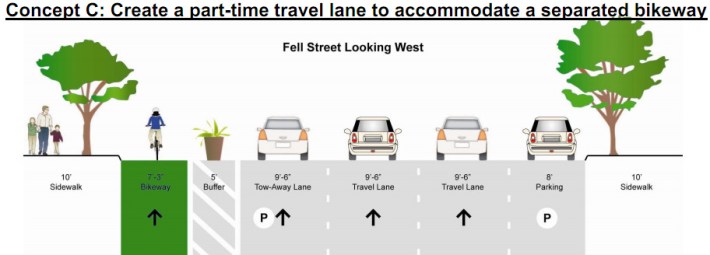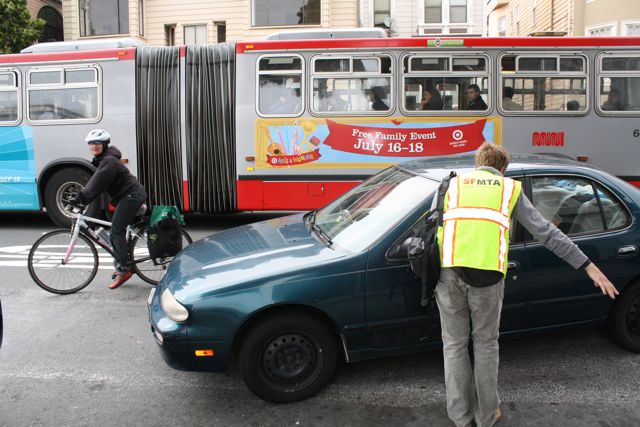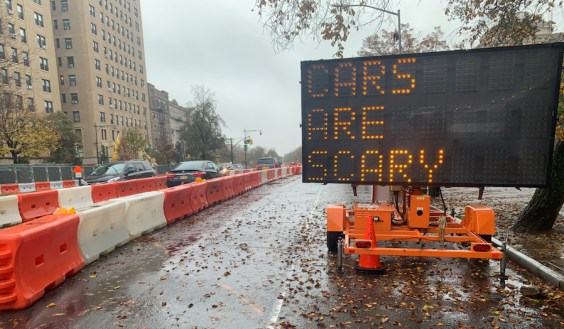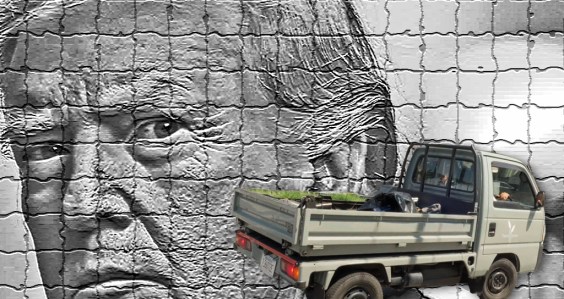
Fourteen years of community-driven efforts to improve conditions on Fell and Oak Streets around the Panhandle are finally paying off. The outreach continues on a vision for separated bikeways that would provide San Franciscans safe access to the flattest route connecting the western neighborhoods to areas east while making the neighborhood more livable for residents and businesses.
For some fifty years, the city has chosen to prioritize automobile storage and speed on Fell and Oak, which serve as one-way, multi-lane residential freeways with car parking lanes on either side. The street invites over 30,000 daily drivers [pdf] (in each direction) to motor through the neighborhood while imposing a dangerous three-block gap for bicycle commuters on the Wiggle route and the Divisadero commercial corridor.
The San Francisco Bicycle Coalition (SFBC), which represents 12,000 members, has surveyed [pdf] nearly all of the businesses along the three blocks of Fell and Oak between Scott and Baker Streets to field initial opinions on a bikeway proposal. Of the three options presented, the survey found most merchants were unsure whether replacing a parking lane, a travel lane, or using a peak-hour tow-away lane would be the best option.
"Only one respondent was explicitly against the project, while most were not against it as long as attention was paid to the concerns, and some were even supportive of the project with no concerns," the survey said.
In June, Mike Sallaberry of the San Francisco Municipal Transportation Agency (SFMTA) Sustainable Streets Division said the bikeway would go in as a trial next summer and made it clear that the agency wants to do its community outreach "correctly and diligently.” This week, SFMTA staff held community meetings with the North of Panhandle Neighborhood Association (NOPNA), the Alamo Square Neighborhood Association, and the Hayes Valley Neighborhood Association.
"There was consensus that the process has to be as public and open as it can be," said NOPNA President Jarie Bolander. "The SFMTA said, of course, that's what they're gonna do. In general, people were optimistic and hopeful that they could then get a safer area for both pedestrians and bicyclists and even cars."
Bolander says there has long been a strong drive among the neighborhood and merchant groups along the Wiggle to make the streets safer and more inviting for people, and that a safe bikeway would be key to reaching those goals.
"For us, we don't see this as car vs. bike or car vs. pedestrian, we see this as an opportunity to make these neighborhoods that are connected by the Wiggle have more of a destination feel," said Bolander. "When people walk around and they feel safe, and it's a destination to come to, they're going to spend more money - neighbors, tourists, people from around the city."
Remy Nelson, president of the Divisadero Merchants Association and owner of Mojo Bicycle Cafe, said that although he is in strong support of the bikeway, members of the group have yet to voice strong opinions about it either way.
"I think there's something to be gained by people traveling more slowly in a commercial district," said Nelson. "It makes them stop, it makes them come and visit things more easily."
NOPNA's spring newsletter this year [pdf] featured a front-page article written by Bolander lauding the proposal, which is a key part of the SFBC's Connecting the City vision.
Here are some selected excerpts from Bolander's piece:
San Francisco is without a doubt one of the most socially integrated cities in the United States, if not the world. A new plan, if implemented, may make it one of the most topographically integrated urban centers as well — with our own neighborhood playing a primary role.
For NOPNA, this plan could be an exciting development. Our collective vision of a revitalized Panhandle encompasses needed repairs, including better paths, more seating and improved playgrounds. A separate Oak-Fell bikeway would provide the needed incentives to make those repairs happen...
Finally, pedestrians play a vital role in road use planning. They are among the most vulnerable users of our roadway infrastructure. When a car swerves to avoid hitting someone, it frequently jeopardizes the safety of other vehicles that, in turn, swerve to avoid hitting it. This chain reaction can snarl roadways and endanger everyone. Safe bicycle and pedestrian infrastructure helps reduce this danger.
Looking beyond our own area, the prospect of improving safety on San Francisco’s streets and sidewalks and connecting them with bicycle routes coincides with NOPNA’s goal of making our own neighborhood more livable and sustainable.
Connecting the City is a bold plan that provides San Francisco with an opportunity to meet the transportation demands of the one million people who are expected to be living and/or working here in the coming decade. Introducing an integrated bicycle and pedestrian network will change how we get to work, shop and ultimately live in this great city.
Just how the project would look will be determined through the SFMTA's outreach, but replacing a car parking lane appears to have fewer obstacles than reclaiming a travel lane. While some car-owning neighbors have complained that there isn't enough free parking to go around, the parking lot at the Department of Motor Vehicles (DMV) on Baker between Fell and Oak recently opened its roughly 120 parking spots to the public after-hours. The two parking lanes on the three blocks of Fell and Oak in question store roughly 80 cars.
"There are other parking options that have come up," said Nelson. "The times when parking is the biggest issue is at night, so freeing up the entire DMV lot makes a difference, we just need people to know about it."
Bolander pointed out that a bikeway would help motorists as well.
"When traffic calming measures are in place, they will be much safer, bicyclists will be much safer, and pedestrians will be much safer," he said.

Replacing a travel lane would likely trigger a longer environmental review process and seems to bring about fears among some critics that there would be unfettered car congestion. Even if the bikeway were to replace a travel lane, Bolander says the trade-offs outweigh any predicted delays and is optimistic they could be mitigated.
"With the plan that we've heard of from the MTA, they could mitigate some of the issues related to narrowing the lanes," he said. "They could time the lights differently so that the flow of traffic during peak times can continue as it has been."
Past cases have shown that reducing road capacity, particularly in favor of more travel options, usually results in a reduction in car travel demand.
Bolander also stressed that extending the bikeways along the Panhandle west of Baker Street would provide a cycling alternative to the crowded Panhandle path and calm motor traffic by replacing the excessive fourth travel lanes on that stretch of Fell and Oak.
"We've had some challenges with the sharing of bicycles and pedestrians," he said. "With bicyclists having a dedicated lane on the street, it frees up the Panhandle for walkers and joggers and moms with their strollers to enjoy the park."

Community efforts to improve the three blocks of Oak and Fell between Scott and Baker are nothing new. On its website last week, the SFBC laid out the timeline of community-driven initiatives and talks with the SFMTA that date back to 1994. Here are some highlights:
- February 1996: Haight Ashbury Neighborhood Council holds public meeting to discuss proposals for traffic calming measures, including removal of a parking lane on Fell and Oak Streets between Scott and Baker to accommodate bike lanes.
- December 1999: Members of the SF Bicycle Coalition, Walk SF, Alamo Square Neighborhood Association, Haight/Divisadero Neighbors and Merchants, Oak/Fillmore Neighborhood Association, Western Addition PAC, North of the Panhandle Neighborhood Association, and Duboce Park Neighborhood Association begin public meetings to advocate for the neighborhoods’ livability. Goals include traffic calming, revitalization, and bike lanes along the Fell and Oak Street corridor.
- September 25, 2001: Rally organized the Senior Action Network, Walk SF, and the SF Bicycle Coalition advocating for a safer Fell Street at Scott Street. Seniors, bicyclists, and pedestrians came together to rally for safety improvements including adding bike lanes on Fell between Scott and Baker to connect to The Wiggle.
- August 2003: Bike lane striped on Fell between Scott and Baker for a six-month trial (followed by a 2004 hearing)
- January 2005: Board of Supervisors unanimously support retaining bike lane on Fell Street.
- November 19, 2009: SF Municipal Transportation Agency presents eight options for addressing the dangers on Fell at Divisadero at a North of Panhandle Neighborhood Association meeting.
- April 30, 2010: SFMTA public hearing, where proposed modifications were presented to accommodate concerns from nearby residents. Four parking spots east of the Arco station would be tow-away zones 7am-7pm instead of 24 hours/day.
- June 29, 2010: Bike lane re-striped on Fell at Divisadero with new left turn only lane configuration for cars turning into Arco gas station and onto Divisadero.
- July 9, 2010: SF Municipal Transportation Agency distributes fliers on-site to people driving about the new configuration of left turn queue lane into the Arco gas station.
- February 23, 2011: Mayor Lee comments that he would like to see a physically separated bike lane on Fell Street between Scott and Baker Street.
In the last few years, numerous neighborhood meetings with the SFMTA and even protests have aimed to protect bicycle riders from drivers on Fell.
The SFMTA will hold a general community meeting on the proposed Fell and Oak bikeways on September 13, 6:30 - 8:00 pm at San Francisco Day School, located at 350 Masonic Avenue.





